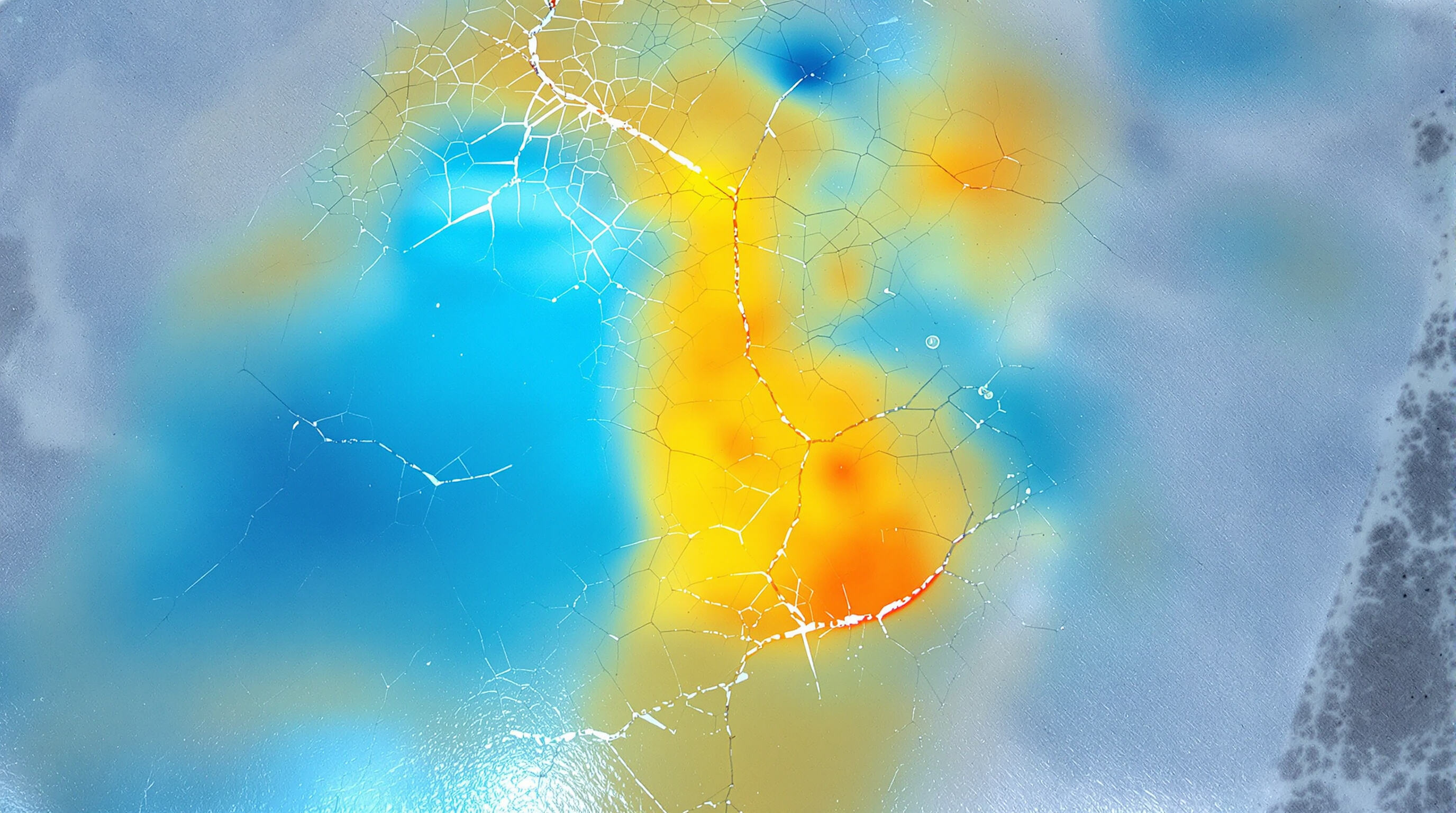Jak akceleratory epoksydowe przyspieszają wiązanie: nauka i wpływ na rzeczywiste zastosowania
Nauka dotycząca mechanizmów aktywacji akceleratorów epoksydowych
Akceleratory epoksydowe obniżają energię aktywacji o nawet 50%, umożliwiając szybsze wiązanie poprzeczne między żywicami a utwardzaczami (Epoxy Curing Agents 2022). Te katalizatory osłabiają wiązania elektrostatyczne w grupach epoksydowych, pozwalając aminom inicjować polimeryzację przy niższych progach energetycznych. To molekularne „pchnięcie” zamienia lepkie żywice w stałe matryce w ciągu minut zamiast godzin.
Analiza kinetyki przyśpieszonego utwardzania żywic epoksydowych na poziomie molekularnym
Kalorymetria różnicowa (DSC) wykazuje, że akceleratory zwiększają szybkość reakcji 3–5-krotnie w porównaniu z układami niekatalizowanymi. W temperaturze 25°C trzeciorzędowe aminy obniżają próg żelowania z 2 godzin do 35 minut, ustalając stany przejściowe podczas ataków nukleofilowych na pierścienie epoksydowe.
Studium przypadku: Skrócenie czasu wiązania adhesyjnego poprzez zastosowanie trzeciorzędowych amin jako akceleratorów
Producenci lotniczy i kosmiczni skrócili cykle klejenia paneli skrzydeł o 68% dzięki zastosowaniu 0,5% benzylo dimetyloaminy. Kleje epoksydowe osiągnęły pełną wytrzymałość w ciągu 90 minut zamiast 4,5 godziny, zachowując 95% podstawowej wytrzymałości na ścinanie (45 MPa).
Trend: Adopcja katalizatorów o szybkim inicjowaniu w liniach montażowych samochodów
Producenci samochodów stosują obecnie utajone pochodne imidazolu, aby skrócić czas wypełniania baterii EV z 8 do 110 minut. Katalizatory te pozostają obojętne poniżej 80°C, zapobiegając przedwczesnemu utwardzaniu podczas wtrysku żywicy.
Dobór akceleratorów epoksydowych do systemów żywic w celu maksymalnej wydajności
Zgodność między aminami alifatycznymi a eterami dwuglicydylowymi
Gdy aminy alifatyczne są używane z żywicami diglikydylowymi (DGEBA), znacznie przyśpieszają reakcję dzięki tym reakcjom transferu protonów, o których tak chętnie mówimy na wykładach z chemii polimerów. Zgodnie z badaniami opublikowanymi w zeszłym roku w „Polymer Journal”, reakcje te faktycznie obniżają energię aktywacji o około 30 do 50 procent w porównaniu z układami bez akceleratorów. Naprawdziwa magia zachodzi jednak wtedy, gdy oba składniki działają razem. Mówimy wtedy o około 95% utworzonych wiązaniach poprzecznych już po dwóch godzinach, nawet w temperaturze pokojowej (około 25 stopni Celsjusza). Dzięki tej właściwości kombinacja ta jest idealna do zastosowań w cienkowarstwowych powłokach ochronnych, gdzie najważniejsze są krótkie czasy utwardzania, ponieważ powolne utwardzanie często prowadzi do nieestetycznych ścieknięć. Większość liderów branżowych stwierdziła, że użycie stosunku aminy do epoksydów wynoszącego około 1 część aminy na 10 części epoksydów pozwala osiągnąć optymalny kompromis między szybkością utwardzania a stabilnością właściwości Tg w czasie.
Dobór akceleratorów do żywic epoksydowych w produkcji kompozytów
Zespoły kompozytowe z branży lotniczej stosują katalizatory typu latent, takie jak kompleksy trifluorku boru z wielofunkcyjnymi żywicami epoksydowymi, umożliwiając 40% szybsze utwardzanie prepregów bez pogorszenia wytrzymałości na ścinanie międzywarstwowe (Composite Structures 2023). W przypadku polimerów wzmocnionych włóknem węglowym dobór akceleratora opiera się na trzech zasadach:
- Stężenie katalizatora ≤ 2% masy żywicy
- Maksymalna temperatura egzotermii poniżej 180°C
- Brak lotnych produktów ubocznych podczas sieciowania
Strategia: Wykorzystanie analizy DSC do prognozowania synergii akcelerator-żywica
Różnicowa kalorymetria skaningowa (DSC) dostarcza danych kinetyki utwardzania, które pozwalają modelować skuteczność akceleratorów w różnych temperaturach. W badaniu z 2024 roku producenci obniżyli wskaźniki wadliwości kompozytów z 22% do 3%, stosując receptury oparte na analizie DSC:
| Parametr | Mieszanka tradycyjna | Mieszanka zoptymalizowana DSC |
|---|---|---|
| Czas żelowania (25°C) | 45 minut | 28 minut |
| Pełna temperatura utwardzenia | 120°c | 95°C |
| Zawartość wolnych przestrzeni | 1.8% | 0.4% |
(Źródło: Instytut Materiałów Kompozytowych 2024)
Unikanie nadmiernego przyspieszania i ryzyka niekontrolowanego wzrostu temperatury

Ryzyko nadmiernego przyspieszania w przypadku grubej warstwy zalewanej żywicy epoksydowej
Gdy materiały schną zbyt szybko, powodują poważne problemy z kontrolą temperatury, szczególnie przy warstwach grubszych niż około 5 milimetrów. Proces ten uwalnia dużą ilość ciepła, czasem przekraczającą 150 stopni Celsjusza, jak wykazały badania przeprowadzone przez ASM International w 2022 roku. To intensywne ciepło prowadzi do powstawania drobnych pęknięć, ponieważ różne części rozszerzają się w różnym tempie, co osłabia ogólną wytrzymałość materiału o około 40 procent w miejscach, które muszą przenosić ciężar. Co gorsza, w przypadku grubszych sekcji ciepło to utrzymuje się jeszcze dłużej. Gdy wiązania chemiczne tworzą się szybciej, generują jeszcze więcej ciepła, tworząc to, co inżynierowie nazywają pętlą sprzężenia zwrotnego. Ten cały cykl skutkuje uszkodzeniem zarówno wytrzymałości konstrukcji, jak i gładkości końcowej powierzchni.
Unikanie termicznej ucieczki w zastosowaniach przemysłowych podłóg
Podłogi epoksydowe przemysłowe wymagają etapowego protokołu nanoszenia, aby zminimalizować reakcje łańcuchowe. Kontraktorzy stosują:
- Wielostopniowe wlewanie (<300 mm² przekroje)
- Mikrosfery borokrzemowe (25–30% redukcja masy)
- Monitorowanie temperatury za pomocą czujników wbudowanych
Takie podejście obniża szczytowe wydzielanie ciepła o 62% w porównaniu do wlewania masowego (Journal of Coatings Technology 2021), przy jednoczesnym zachowaniu czasu dozwolonego obchodzenia w ciągu <2 godzin, wymaganego przez hale produkcyjne.
Analiza kontrowersji: Prędkość vs. Integralność konstrukcyjna w przyspieszonym dojrzewaniu
Trafiało się dość sporo dyskusji wśród ekspertów od żywic epoksydowych, czy przyśpieszenie procesu utrwalania faktycznie osłabia strukturę polimeru. Szybko działające akceleratory osiągają około 90% utrwalenia już po 45 minutach, jednak te, które działają wolniej, zazwyczaj tworzą znacznie gęstsze wiązania poprzeczne, około 18 do 22 procent zgodnie z testami ASTM D4065. Dla producentów korzystających z klejów strukturalnych powstaje w ten sposób pewien dylemat. Muszą zdecydować, czy preferują szybsze cykle produkcyjne, czy lepszą trwałość określoną normą ASTM C881-20. Większość firm ocenia te czynniki w kontekście konkretnych potrzeb aplikacyjnych, zamiast wybierać jedno, uniwersalne rozwiązanie.
Mechanizmy Molekularne Reakcji Epoksydów z Akceleratorami
Mechanizmy Ataku Nukleofilowego Ułatwionego przez Akceleratory Na Bazie Imidazolu
Akceleratory na bazie imidazolu inicjują utwardzanie poprzez nukleofilowy atak na pierścienie epoksydowe. Bogate w elektrony atomy azotu w związkach imidazolowych atakują elektrofilowe atomy węgla w grupach epoksydowych, uruchamiając reakcje otwierania pierścienia, które tworzą wiązania kowalencyjne. Ten mechanizm przyspiesza sieciowanie bez konieczności aktywacji cieplnej.
Reakcje chemiczne między żywicą epoksydową a akceleratorami w układach utwardzanych bezwodnikami
W układach epoksydowych utwardzanych bezwodnikami akceleratory wspomagają reakcje estryfikacji między pochodnymi kwasów karboksylowych a grupami hydroksylowymi. Badania z 2022 roku opublikowane w Journal of Materials Research and Technology wykazały, że konkretne katalizatory amonowe obniżają energię aktywacji tego procesu o 35–40%, umożliwiając szybsze czasy żelowania w produkcji kompozytów.
Rola wiązań wodorowych w zwiększaniu gęstości sieciowania
Pomiędzy cząsteczkami akceleratora a pośrednimi produktami epoksydowymi powstają wiązania wodorowe, które stabilizują stany przejściowe podczas sieciowania. Badania wykazują, że to oddziaływanie zwiększa gęstość sieciowania o 22% w porównaniu z systemami niekatalitycznymi, bezpośrednio zwiększając wytrzymałość mechaniczną klejów i powłok.
Analiza danych: Spektroskopia FTIR ujawnia szybkość tworzenia się wiązań w czasie rzeczywistym
Spektroskopia FTIR (Fouriera z transformacją transformaty) w czasie rzeczywistym ujawnia, że reakcje epoksyd-akcelerator osiągają 90% utworzenia wiązań w ciągu 8 minut w optymalnych warunkach. Ostatnie dane potwierdzają, że ta szybka kinetyka umożliwia precyzyjną kontrolę profili utwardzania w klejach stosowanych w przemyśle lotniczym.
Optymalizacja czasu utwardzania w powłokach i zastosowaniach w niskich temperaturach

Skracanie czasu utwardzania lakierów epoksydowych w zastosowaniach morskich
Narażenie na wodę morską wymaga szybkiego utwardzania, aby zapobiec degradacji kleju. Modyfikowane akceleratory z grupy amin cykloalifatycznych skracają czas utwardzania farb epoksydowych do 2,5 godziny w strefach chlapania (w porównaniu do 6 godzin dla nieprzyspieszonych), zachowując 98% wytrzymałości połączenia po 12-miesięcznych testach poddania w komorze solnej (ASTM B117-23).
Kompromis między szybkością a trwałością w pracach malarskich z zastosowaniem farb epoksydowych z modyfikowanymi imidazolami
Pochodne imidazolu, takie jak 2-etylo-4-metyloimidazol (EMI), zwiększają gęstość sieciowania bez nadmiernego efektu egzotermicznego. Nowe składniki osiągają czas zdatności do 45 minut, zachowując wytrzymałość na rozciąganie >90 MPa – kluczowe dla kadłubów statków wymagających odporności na uderzenia.
Rozwiązania do utwardzania w niskich temperaturach z zastosowaniem katalizatorów latentnych (5–15°C)
Latentne akceleratory oparte na dicyjanodiamidzie aktywują się przy ≤7°C, umożliwiając cykle utwardzania o 30% szybsze niż w przypadku tradycyjnych amin w warunkach arktycznych. Ta technologia wspiera utrzymaniowe farm wiatrowych offshore z temperaturą przejścia szklistego (Tg) na poziomie -10°C, potwierdzoną analizą DMA.
Studium przypadku: Montaż łopat turbin wiatrowych w warunkach klimatu chłodnego
W projekcie instalacji w Arktyce w 2023 roku do utwardzania 60-metrowych łopat na bazie żywicy epoksydowej w ciągu 8 godzin w temperaturze -5°C zastosowano kompleksy trifluorku boru z aminą, co wyeliminowało dotychczasowe namioty grzejne zużywające dziennie 2400 kWh energii. Testy zrywania wykazały wytrzymałość na poziomie 18 N/mm – przekraczającą normę ISO 4587 o 22%.
Często zadawane pytania
Czym jest akcelerator do żywic epoksydowych?
Akcelerator do żywic epoksydowych to katalizator stosowany w celu zmniejszenia energii aktywacji wymaganej do procesu utrwalania żywic epoksydowych, przyspieszający tym samym reakcję i wzmocnienia wiązania.
Czy akceleratory do żywic epoksydowych są bezpieczne w użyciu?
Akceleratory do żywic epoksydowych są zazwyczaj bezpieczne przy stosowaniu zgodnie z instrukcjami producenta, jednak należy zachować ostrożność, aby unikać wdychania oparów i prawidłowo obsługiwać materiały.
Czy akceleratory mogą być stosowane we wszystkich systemach żywic epoksydowych?
Akceleratory mogą być dopasowywane do konkretnych systemów żywic epoksydowych, jednak zawsze należy sprawdzić ich kompatybilność, by uniknąć niepełnego utrwalenia lub niepożądanych reakcji.
Czy akceleratory wpływają na wytrzymałość utwardzonych materiałów?
Mimo że przyspieszają proces utrwalania, niektóre domieszki mogą wpływać negatywnie na gęstość i wytrzymałość utrwalonego produktu, jeśli nie zostaną odpowiednio wykorzystane.
Spis treści
-
Jak akceleratory epoksydowe przyspieszają wiązanie: nauka i wpływ na rzeczywiste zastosowania
- Nauka dotycząca mechanizmów aktywacji akceleratorów epoksydowych
- Analiza kinetyki przyśpieszonego utwardzania żywic epoksydowych na poziomie molekularnym
- Studium przypadku: Skrócenie czasu wiązania adhesyjnego poprzez zastosowanie trzeciorzędowych amin jako akceleratorów
- Trend: Adopcja katalizatorów o szybkim inicjowaniu w liniach montażowych samochodów
- Dobór akceleratorów epoksydowych do systemów żywic w celu maksymalnej wydajności
- Unikanie nadmiernego przyspieszania i ryzyka niekontrolowanego wzrostu temperatury
-
Mechanizmy Molekularne Reakcji Epoksydów z Akceleratorami
- Mechanizmy Ataku Nukleofilowego Ułatwionego przez Akceleratory Na Bazie Imidazolu
- Reakcje chemiczne między żywicą epoksydową a akceleratorami w układach utwardzanych bezwodnikami
- Rola wiązań wodorowych w zwiększaniu gęstości sieciowania
- Analiza danych: Spektroskopia FTIR ujawnia szybkość tworzenia się wiązań w czasie rzeczywistym
-
Optymalizacja czasu utwardzania w powłokach i zastosowaniach w niskich temperaturach
- Skracanie czasu utwardzania lakierów epoksydowych w zastosowaniach morskich
- Kompromis między szybkością a trwałością w pracach malarskich z zastosowaniem farb epoksydowych z modyfikowanymi imidazolami
- Rozwiązania do utwardzania w niskich temperaturach z zastosowaniem katalizatorów latentnych (5–15°C)
- Studium przypadku: Montaż łopat turbin wiatrowych w warunkach klimatu chłodnego
- Często zadawane pytania

